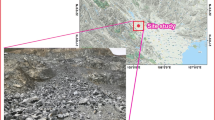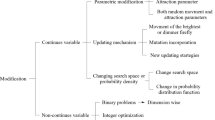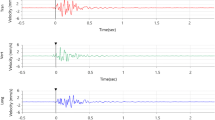Abstract
In this investigation, a new technique termed Firefly-XGBoost was developed to forecast and reconcile blasting results like mean fragmentation size (MFS) and peak particle velocity (PPV). As a result, the particle swarm optimization (PSO) algorithm and firefly algorithm were used to enhance the effectiveness of the XG Boost conventional model. A total of 152 blast experiments were performed at three different mines, and data acquired from these experiments were used to train the model. This data included special feature of joints spanning height (JSH), and other blast parameters like the number of joint sets, the total quantity of explosives, stemming length, decking length, maximum charge/delay, and rock uni-axial compressive strength (UCS).The XG Boost, PSO-XG Boost, and Firefly XG Boost algorithms were compared, and the Firefly-XG Boost findings were superior according to RMSE and R2 values.
Similar content being viewed by others
Data availability
Available in https://github.com/SriChandrahas/XGBoost-Public/blob/ 6c14d4a4ae26f6c8f3c6e2763594235c5145eee2/XGBOOST_FRAG.ipynb.
References
Hagan, T.N.: The influence of controllable blast parameters on fragmentation and miningcosts, Proceedings1stInternational Symposium on Rock Fragmentation by Blasting, Lülea, Sweden, Vol.1, pp. 31-32. (1983)
Esmaeili, M., AlireazaSalimi, C.D., Abbaszadeh, M., Bazzazi, A.A.: Application of PCA, SVR, and ANFIS for modeling of rock fragmentation. Arab J. Geosci. 8, 6881–6893 (2015). https://doi.org/10.1007/s12517-014-1677-3
Hakan, Ak., Melih, I., Mahmut, Y., Adnan, K.: Evaluation of ground vibration effect of blasting operations in a magnesite mine. Soil Dyn. Earthq. Eng. 29, 669–676 (2009)
Chiappetta, R.F., Borg, D.G., Sterner, V.A.: Explosives and Rock Blasting, p. 233. Atlas Powder Company, Dallas (1987)
Chandrahas, S.N., Choudhary, B.S., Krishna Prasad, N.S.R., Musunuri, V., Rao, K.K.: An investigation into the effect of rockmass properties on mean fragmentation. Arch. Min. Sci. 66, 561–578 (2021). (CrossRef)
Choudhary, B.S., Sonu, K., Kishore, K., Anwar, S.: Effect of rock mass properties on blast-induced rock fragmentation. Int. J. Min. Miner. Eng. 7(2), 89–101 (2016). https://doi.org/10.1504/IJMME.2016.076489
La Pointe, P.R., Ganow, H.G.: The influence of cleats and joints on production blast fragment size in the Wyodak Coal, Compbell Country, Wyoming, in Proceedings of the 27th US Symposium on Rock Mechanics, University of Alabama. pp. 464–70. (1986)
Goodman, R.E., Shi, G.H.: Block Theory and its Application to Rock Engineering. Prentice-Hall, Englewood Cliffs (1985)
Chakraborty, A.K., Jethwa, J.L., Paithankar, A.G.: Assessing the effects of joint orientation and rock mass quality on fragmentation and overbreak in tunnel blasting. Tunn. Undergr. Space Technol. 9(4), 471–482 (1994). https://doi.org/10.1016/0886-7798(94)90106-6
Ouchterlony, F.: What does the fragment size distribution of blasted rock looklike? Third European Federation of Explosives Engineers (EFEE) World Conference onExplosives and Blasting / [ed] R. Holmberg, European Federation of Explosives Engineers, 2005, pp. 189–199. (1996)
Mandl, G.: Rock Joints: The Mechanical Genesis, p. 221. Springer-Verlag, Heidelberg, Germany (2005). (ISBN 978-3-540-24553-7)
Davis, G.H., Reynolds, S.J., Kluth, C.: Structural Geology of Rocks and Regions, 3rd edn., p. 864. Wiley, New York (2012). (ISBN 978-0471152316)
Goudie, A.S.: Encyclopedia of Geomorphology volume 2 J–Z, p. 578. Routledge New York, New York (2004). (ISBN 9780415327381)
Goodman, R.E.: Methods of Geological Engineering in Discontinuous Rock. West Publishing, St. Paul (1976)
King, M., Myerand, L., Rezowalli, J.: Experimental studies of elastic-wave propagation in a columnar-jointed rock mass. Geophys. Prospect. 34, 1185–1199 (1986). https://doi.org/10.1111/j.1365-2478.1986.tb00522.x
Berta, G.: Blasting-induced vibration in tunneling. Tunn. Undergr. Space Technol. 9, 175–187 (1994). https://doi.org/10.1016/0886-7798(94)90029-9
Belland, J.M.: Structure as a control in rock fragmentation coal lake iron ore deposited. Can. Min. Metall. Bull. 59(647), 323–328 (1968)
Fourney, W.L.: Mechanisms of rock fragmentation in by blasting. In: Hudson, J.A. (ed.) Compressive Rock Engineering, Principles, Practice and Projects. Pergamon Press, Oxford (1993)
Paswan, R.K., Mohammad, S., Singh, P.K., Khare, H.S., Singh, B.K., Singh, R.J.: Controlled blasting at Parsa East & KantaBasan opencast mines for safe and efficient Mining operations. Ind. Min. Eng. J. 53(4), 7–17 (2014)
Jimeno, C.L., Jimeno, E., Carcedo, F.J.A.: drilling and Blasting of Rocks. A.A. Balkema Publishers, Rotterdam (1995)
Lewandowski, T.H., Luan Mai, V.K., Danell, R.E.: Influence of Discontinuities on Pre-splitting Effectiveness, Rock Fragmentation by Blasting – Fragblast5. B. Mohanty, Montreal (1996)
Ash, R.L.: The Influence of Geological Discontinuities on Rock Blasting. Ph.D. Thesis, University of Minnesota, Minneapolis (1973)
Van Zyl: An approach to incorporate rock fabric information in blast fragmentation investigation. In Proceedings of the 2nd Mini-Symposium on Explosives and Blasting research, Society of Explosives Engineers, georgia. pp. 81–89 (1986)
Efremov, E.I., Komi, V.M., Myachina, N.I., Nikiforova, V.A., Rodak, S.N., Shelenok, V.V.: Influence of the structure of a medium on fragment size composition in blasting. Sov. Min. Sci. 16, 18–22 (1980). https://doi.org/10.1007/BF02504281
Wua, Y.K., Haoa, H., Zhoub, Y.X., Chongb, K.: Propagation characteristics of blast-induced shock waves in a jointed rock mass. Soil Dyn. Earthq. Eng. 17, 407–412 (1998). https://doi.org/10.1016/S0267-7261(98)00030-X
Singh, J., Verma, A.K., Banka, H., Singh, T.N., Maheshwar, S.: A study of soft computing models for prediction of longitudinal wave velocity. Arab J. Geosci. 9, 224 (2016). https://doi.org/10.1007/s12517-015-2115
Jhanwar, J.C., Chakraborty, A.K., Ani Reddy, H.R., Jethwa, J.L.: Application ofair decks in production blasting to improve fragmentation and economics of an open pit mine. Geotech. Geol. Eng. J. 417, 37–57 (1999). https://doi.org/10.1023/A:1008899928839
Jhanwar, J., Jethwa, J.: The use of air decks in production blasting in an open pit coal mine. J. Geotech. Geol. Eng. 18(4), 269–287 (2000)
Park, D., Jeon, S.: Reduction of blast-induced vibration in the direction of tunneling using an Air-Deck at the bottom of a Blasthole. Int. J. Rock Mech. Min. Sci. 47(5), 752–761 (2010)
Chi, E.A., Liang, K.S., Zhao, M.S.: Experimental study on vibration reduction of the hole bottom air space charging. J. China Coal Soc. 37(6), 944–950 (2012)
Abdall, M.: The Environmental Impacts of Air-Deck Blasting. University of New South Wales (2014)
Hayat, M.B., Alagha, L., Ali, D.: Air decks in surface blasting operations. J. Min. Sci. 55(6), 922–929 (2019)
Roy, S., Singh, R.S.: Use of spacer aided initiation technique in solid blasting in Indian underground coal mines. J. Min. Tech. 120(1), 25–35 (2011)
David, E., Siskind, Vigil, J., Stachura: Surface Mine Blasting. Proceedings: Bureau of Mines Technology Transfer Seminar. Chicago (1987)
Sri Chandrahas, N., Choudhary, B.S., Vishnu Teja, M., Venkataramayya, M.S., Krishna Prasad, N.S.R.: XG boost algorithm to simultaneous prediction of rock fragmentation and induced ground vibration using unique blast data. Appl. Sci. 12(10), 5269 (2022). https://doi.org/10.3390/app12105269
Singh, R., Kainthola, A., Singh, T.N.: Estimation of elastic constant of rocks using an ANFIS approach. Appl. Soft Comput. 12(1), 40-45 22 (2012). https://doi.org/10.1016/j.asoc.2011.09.010
Mishnaevsky, L.L., Jr.: Physical mechanisms of hard rock fragmentation under mechanical loading: A review. Int. J. Rock Mech. Min. Sci. Geomech. Abstr. 32(8), 763–766 (1995). https://doi.org/10.1016/0148-9062(95)00027-E
Sayadi, A., Manojezi, M., Talebi, N., Khandelawal: A comparative study on the application of various artificial neural networks to simultaneous prediction of rock fragmentation and back break. J. Rock Mech. Geotech. Eng. 5, 318–324 (2013)
Dindarloo, S.R.: Peak particle velocity prediction using support vector machines: A surface blasting case study. J. S. Afr. Inst. Min. Metall. 115, 637–643 (2015)
Ebrahimi, E., Monjezi, M., Khalesi, M.R., Armaghani, D.J.: Prediction and optimization of back-break and rock fragmentation using an artificial neural network and a bee colony algorithm. Bull. Eng. Geol. Environ. 75, 27–36 (2015)
Monjezi, M., Bahrami, A., YazdianVarjani, A.: Simultaneous prediction of fragmentation and flyrock in blasting operation using artificial neural networks. Int. J. Rock Mech. Min. Sci. 47(3), 476–480 (2010). https://doi.org/10.1016/j.ijrmms.2009.09.008
Shi, X.Z., Zhou, J., Wu, B., Huang, D., Wei, W.: Support vector machines approach to mean particle size of rock fragmentation due to bench blasting prediction. Trans. Nonferrous Met. Soc. China 22, 432–441 (2012). https://doi.org/10.1016/S1003-6326(11)61195-3
Armaghani, D.J., Momeni, E., Abad, S.V.A.N.K., Khandelwal, M.: Feasibility of ANFIS model for prediction of ground vibrations resulting from quarry blasting. Environ. Earth Sci. 74, 2845–2860 (2015)
Armaghani, D.J., Hasanipanah, M., Bakhshandeh Amnieh, H., Mohamad, E.T.: Feasibility of ICA in approximating ground vibration resulting from mine blasting. Neural Comput. Appl. 29, 457–465 (2018)
Nguyen, H., Bui, X.-N., Bui, H.-B., Cuong, D.T.: Developing an XGBoost model to predict blast-induced peak particle velocity in an open-pit mine: a case study. Acta Geophys. (2019). https://doi.org/10.1007/s11600-019-00268-4
Qin, C., Zhang, Y., Bao, F., Zhang, C., Liu, P., Liu, P.: XGBoost optimized by adaptive particle swarm optimization for credit scoring. Hindawi Math. Probl. Eng. 2021, 18 (2021). https://doi.org/10.1155/2021/6655510. (Article ID 6655510)
Bergstra, J., Bengio, Y.: Random search for hyper-parameter optimization. J. Mach. Learn. Res. 13(1), 281–305 (2012)
Eberhart, R.C., Kennedy, J.: A new optimizer using particle swarm theory. In Proceedings of the MHS’95. Proceedings of the Sixth International Symposium on Micro Machine and Human Science. Nagoya, Japan (1995)
Yang, Q., Chen, W.N., Deng, J.D.: A level-based learning swarm optimizer for large-scale optimization. IEEE Trans. Evol. Comput. 22(99), 578–594 (2018)
Yang, X.-S.: Firefly algorithms for multimodal optimization. In: International Symposium on Stochastic Algorithms, pp. 169–178. Springer, Berlin (2009)
Fister, I., Yang, X.S., Brest, J., Fister Jr, I.: Memetic self-adaptive firefly algorithm. Swarm Intell. Bio-Inspired Comput.: Theory Appl., 73–102 (2013)
Zhou, L., Ma, M., Ding, L., Tang, W.: Centroid opposition with a two-point full crossover for the partially attracted firefly algorithm. Soft Comput. 23, 12241–12254 (2019). https://doi.org/10.1007/s00500-019-04221-x
Bayat, P., Monjezi, M., Rezakhah, M., Armaghani, D.J.: Artificial neural network and firefly algorithm for estimation and minimization of ground vibration induced by blasting in a mine. Nat. Resour. Res. 29, 4121–4132 (2020)
Yang, H., Nikafshan Rad, H., Hasanipanah, M., Bakhshandeh Amnieh, H., Nekouie, A.: Prediction of vibration velocity generated in mine blasting using support vector regression improved by optimization algorithms. Nat. Resour. Res. 29, 807–830 (2020)
Zhu, W., Nikafshan Rad, H., Hasanipanah, M.: A chaos recurrent ANFIS optimized by PSO to predict ground vibration generated in rock blasting. Appl. Soft Comput. 108, 107434 (2021)
Hasanipanah, M., Armaghani, D.J., Amnieh, H.B., Abd Majid, M.Z., Tahir, M.M.D.: Application of PSO to develop a powerful equation for prediction of flyrock due to blasting. Neural Comput. Appl. 28(Supplement 1), 1043–1050 (2016)
Armaghani, D.J., Hajihassani, M., Mohamad, E.T., Marto, A., Noorani, S.A.: Blasting-induced flyrock and ground vibration prediction through an expert artificial neural network based on particle swarm optimization. Arab. J. Geosci. 7, 5383–5396 (2014)
Hajihassani, M., Armaghani, D.J., Monjezi, M., Tonnizam, M.E., Marto, A.: Blast-induced air and ground-vibration prediction: A particle swarm optimization-based artificial neural network approach. Environ. Earth Sci. 74(4), 2799–2817 (2015)
Saghatforoush, A., Monjezi, M., Shirani Faradonbeh, R., Armaghani, D.: Combination of neural network and ant colony optimization algorithms for prediction and optimization of flyrock and back-break induced by blasting. Eng. Comput. 32(2), 255–266 (2016)
Friedman, J.H.: Stochastic gradient boosting. Comput. Stat. Data Anal. 38, 367–378 (2022). (CrossRef)
Chen, M., Liu, Q., Chen, S., Liu, Y., Zhang, C.-H., Liu,: R. XGBoost-based algorithm interpretation and application on post-fault transient stability status prediction of power system. IEEE Access 7, 13149–13158 (2019). (CrossRef)
Friedman, J., Hastie, T., Tibshirani, R.: Additive logistic regression: A statistical view of boosting (with discussion and a rejoinder by the authors). Ann. Stat. 28, 337–407 (2000)
Chen, T.H.: T. Xgboost: Extreme Gradient Boosting; R Package Version 04-2 (2015). Available online: https://cran.microsoft.com
Gao, W., Wang, W., Dimitrov, D., Wang, Y.: Nano properties analysis via fourth multiplicative ABC indicator calculating. Arab. J. Chem. 11, 793–801 (2018)
Zhou, J., Li, C., Arslan, C.A., Hasanipanah, M., Amnieh, H.B.: Performance evaluation of hybrid FFA-ANFIS and GA-ANFIS models to predict particle size distribution of a muck-pile after blasting. Eng. Comput. (2019). https://doi.org/10.1007/s00366-019-00822
Ezugwu, A.E., Akutsah, F.: Digital object identifier improved firefly algorithm for the unrelated parallel machines scheduling problem with sequence-dependent setup times. IEEE Accesses (2018). https://doi.org/10.1109/ACCESS.2018.2872110
Yang, X.S.: Firefly algorithm, stochastic test functions and design optimisation. IJBIC 2, 78 (2010)
Xie, C., Nguyen, H., Bui, X.N., Choi, Y., Zhou, J., Nguyen-Trang.T,: Predicting rock size distribution in mine blasting using various novel soft computing models based on meta-heuristics and machine learning algorithms. Geosci. Front. (2020). https://doi.org/10.1016/j.gsf.2020.11.005
Hasanipanah, M., Naderi, R., Kashir, J., Noorani, S.A., Qaleh, A.Z.A.: Prediction of blast produced ground vibration using particle swarm optimization. Eng. Comput. 33(2), 173–179 (2016)
Gordan, B., Jahed Armaghani, D., Hajihassani, M., Monjezi, M.: Prediction of seismic slope stability through combination of particle swarm optimization and neural network. Eng. Comput. 32(1), 85–97 (2016)
Ghasemi, E., Kalhori, H., Bagherpour, R.: A new hybrid ANFIS–PSO model for prediction of peak particle velocity due to bench blasting. Eng. Comput. 32(4), 607–614 (2016)
Eberhart, R.C., Kennedy, J.: A new optimizer using particle swarm theory. In Proceedings of the sixth international symposium on micro machine and human science, volume 43. New York, NY, USA: IEEE (1995)
Acknowledgements
I would like to express my heartfelt gratitude to my mentor, B.S. Choudhary, Associate Professor, IIT (ISM) Dhanbad, for meticulously tracking and adding his research inputs to this paper. I am always grateful to my college IIT (ISM) Dhanbad. I would like to express my gratitude to the Principal, Director, and management of Malla Reddy Engineering College, Hyderabad for allocating adequate time to carry out research.
Funding
This research received no external funding. Informed Consent Statement: Informed consent was obtained from all subjects involved in the study.
Author information
Authors and Affiliations
Contributions
Conceptualization, methodology, investigation, software and writing— original draft preparation has been conducted by N Sri Chandrahas.; supervision and formal analysis have been conducted by BS Choudhary., writing—review and editing done by M.S.Venkataramayya. All authors have read and agreed to the published version of the manuscript.
Corresponding author
Ethics declarations
Conflicts of interest
The authors declare no conflict of interest.
Additional information
Publisher's Note
Springer Nature remains neutral with regard to jurisdictional claims in published maps and institutional affiliations.
Rights and permissions
Springer Nature or its licensor (e.g. a society or other partner) holds exclusive rights to this article under a publishing agreement with the author(s) or other rightsholder(s); author self-archiving of the accepted manuscript version of this article is solely governed by the terms of such publishing agreement and applicable law.
About this article
Cite this article
Chandrahas, N.S., Choudhary, B.S. & Venkataramayya, M.S. Competitive algorithm to balance and predict blasting outcomes using measured field data sets. Comput Geosci 27, 1087–1110 (2023). https://doi.org/10.1007/s10596-023-10254-x
Received:
Accepted:
Published:
Issue Date:
DOI: https://doi.org/10.1007/s10596-023-10254-x




